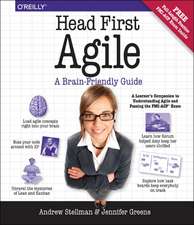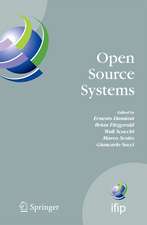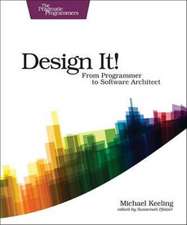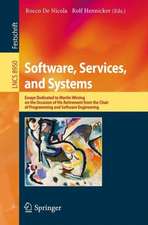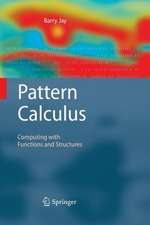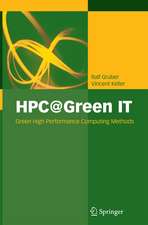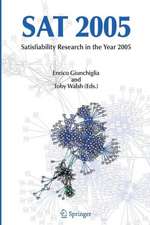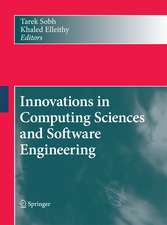ESEC '91: 3rd European Software Engineering Conference, ESEC '91, Milan, Italy, October 21-24, 1991. Proceedings: Lecture Notes in Computer Science, cartea 550
Editat de Axel van Lamsweerde, Alfonso Fuggettaen Limba Engleză Paperback – 9 oct 1991
Din seria Lecture Notes in Computer Science
- 20%
 Preț: 1061.55 lei
Preț: 1061.55 lei - 20%
 Preț: 307.71 lei
Preț: 307.71 lei - 20%
 Preț: 438.69 lei
Preț: 438.69 lei - 20%
 Preț: 579.30 lei
Preț: 579.30 lei -
 Preț: 410.88 lei
Preț: 410.88 lei - 17%
 Preț: 427.22 lei
Preț: 427.22 lei - 20%
 Preț: 596.46 lei
Preț: 596.46 lei - 15%
 Preț: 448.04 lei
Preț: 448.04 lei - 20%
 Preț: 353.50 lei
Preț: 353.50 lei -
 Preț: 389.49 lei
Preț: 389.49 lei - 20%
 Preț: 309.90 lei
Preț: 309.90 lei - 20%
 Preț: 645.28 lei
Preț: 645.28 lei - 20%
 Preț: 763.23 lei
Preț: 763.23 lei - 15%
 Preț: 580.46 lei
Preț: 580.46 lei - 20%
 Preț: 310.28 lei
Preț: 310.28 lei - 20%
 Preț: 655.02 lei
Preț: 655.02 lei - 20%
 Preț: 1183.14 lei
Preț: 1183.14 lei - 20%
 Preț: 340.32 lei
Preț: 340.32 lei -
 Preț: 449.57 lei
Preț: 449.57 lei - 20%
 Preț: 591.51 lei
Preț: 591.51 lei - 18%
 Preț: 938.83 lei
Preț: 938.83 lei - 20%
 Preț: 337.00 lei
Preț: 337.00 lei - 20%
 Preț: 649.50 lei
Preț: 649.50 lei - 20%
 Preț: 607.40 lei
Preț: 607.40 lei - 20%
 Preț: 1414.79 lei
Preț: 1414.79 lei - 20%
 Preț: 1024.44 lei
Preț: 1024.44 lei - 20%
 Preț: 583.40 lei
Preț: 583.40 lei - 20%
 Preț: 453.32 lei
Preț: 453.32 lei - 20%
 Preț: 575.49 lei
Preț: 575.49 lei - 20%
 Preț: 1075.26 lei
Preț: 1075.26 lei - 20%
 Preț: 585.88 lei
Preț: 585.88 lei - 20%
 Preț: 825.93 lei
Preț: 825.93 lei - 17%
 Preț: 360.20 lei
Preț: 360.20 lei - 20%
 Preț: 763.23 lei
Preț: 763.23 lei - 20%
 Preț: 340.32 lei
Preț: 340.32 lei - 20%
 Preț: 504.58 lei
Preț: 504.58 lei - 20%
 Preț: 369.13 lei
Preț: 369.13 lei - 20%
 Preț: 580.93 lei
Preț: 580.93 lei - 20%
 Preț: 343.62 lei
Preț: 343.62 lei - 20%
 Preț: 350.21 lei
Preț: 350.21 lei - 20%
 Preț: 583.40 lei
Preț: 583.40 lei - 20%
 Preț: 583.40 lei
Preț: 583.40 lei - 15%
 Preț: 438.59 lei
Preț: 438.59 lei - 20%
 Preț: 341.95 lei
Preț: 341.95 lei - 20%
 Preț: 238.01 lei
Preț: 238.01 lei - 20%
 Preț: 538.30 lei
Preț: 538.30 lei
Preț: 344.27 lei
Preț vechi: 430.34 lei
-20% Nou
Puncte Express: 516
Preț estimativ în valută:
65.90€ • 71.60$ • 55.39£
65.90€ • 71.60$ • 55.39£
Carte tipărită la comandă
Livrare economică 21 aprilie-05 mai
Preluare comenzi: 021 569.72.76
Specificații
ISBN-13: 9783540547426
ISBN-10: 3540547428
Pagini: 532
Ilustrații: XII, 520 p.
Dimensiuni: 155 x 233 x 28 mm
Greutate: 0.74 kg
Ediția:1991
Editura: Springer Berlin, Heidelberg
Colecția Springer
Seria Lecture Notes in Computer Science
Locul publicării:Berlin, Heidelberg, Germany
ISBN-10: 3540547428
Pagini: 532
Ilustrații: XII, 520 p.
Dimensiuni: 155 x 233 x 28 mm
Greutate: 0.74 kg
Ediția:1991
Editura: Springer Berlin, Heidelberg
Colecția Springer
Seria Lecture Notes in Computer Science
Locul publicării:Berlin, Heidelberg, Germany
Public țintă
ResearchCuprins
Software configuration management: Past uses and future challenges.- Architectural design for user interfaces.- The Eureka Software Factory: Concepts and accomplishments.- Integrating structured and formal methods: A visual approach to VDM.- Rational design of distributed applications.- Test data selection from algebraic specifications: Application to an automatic subway module.- Specification in COLD-1 of a CAD package for drawing shadow masks.- ASTRAL: An assertion language for specifying realtime systems.- Execution environment for ELECTRE applications.- An engineering approach to hard real-time system design.- An application of artificial intelligence to prototyping process in performance design for real-time systems.- Dynamically Replaceable Software: A design method.- Software merge: Models and methods for combining changes to programs.- A theory for software design extraction.- SESADA: An environment supporting software specialization.- Metric-driven classification analysis.- A dynamic failure model for predicting the impact that a program location has on the program.- Relation between source code metrics and structure analysis metrics.- Algebraic validation of software metrics.- An algebraic view of inheritance and subtyping in object oriented programming.- Scaling up rule-based software development environments.- Inference-based support for programming in the large.- TICKLE: Object-oriented description and composition services for software engineering environments.- Integrated project support environments, text generation and technical writing.- The Arcs experience.- Panel presentation.- The production of software in the FINSIEL group.- The impact of software engineering researches on industrial practice — a personal view.- Impact of methods on productivity &quality.- Requirements engineering — Getting right from wrong.- A (neat) alphabet of requirements engineering issues.- The scruffy side of requirements engineering.- Expediency and appropriate technology: An agenda for requirements engineering research in the 1990s.- CASE support for the software process.- CASE support for the software process: A research viewpoint.- CASE support for large systems.- CASE seen from both sides of the fence.- CASE support for the software process: Advances and problems.











